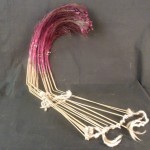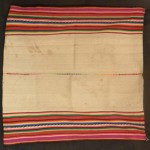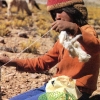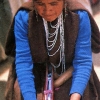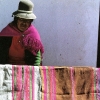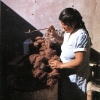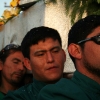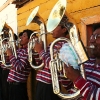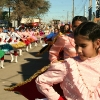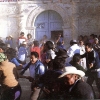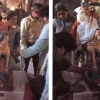Settlement patterns
The Aymara have a number of subgroups, each with its own territory or marka, centered around a political, social and religious capital. The marka consists of the ayllu, the human community; the sallqa, the surrounding wilderness where plants and animals live; and the huacas, composed of Pachamama, the mountain spirits and other ‘powerful’ places, the stars, and other personified phenomena. These distinct spheres of creation interact and overlap in the home, in the family agricultural plot, in the grazing lands and pastures, and beyond them, in the wilderness. Together, they make up the Akapacha, which sits between a higher world, Arajpacha, and a lower world, known as Manqhapacha. The Arajpacha is associated with all that is good, the Manqhapacha with its opposite. They balance each other at a central point of exchange, fertile and firm, known as the Tinku. Today, the unity of the marka is expressed in festivals that are held in the Aymara capitals, where people representing the different Aymara sub-groups and territories uphold their traditions, though they no longer live in a cohesive social structure. The territory of the marka is divided into two halves or sayas, and four sectors, ayllus. The primary division is symbolic, and includes the higher world/lower world distinction (Arajsaya/Manqhasaya), while the secondary division is economic, and separates the high mountain herders from the farmers of the foothills. These segments complement each other and together form the whole.
The Aymara use several types of dwelling. The first, used in the summertime marka festivals, is located in the part of town that houses the upper ayllu. Then there is the dwelling place known as the uta, used throughout the year in rural areas. This adobe residence is rectangular in shape and constructed on a stone foundation, with a pitched roof and beams made from keñua wood. It contains separate modules for the kitchen, sleeping area, and food storage, and its door points eastward. The structure is windowless, to keep out the cold. The Aymara’s believe their houses are living things, and decorate them with two wreaths or woolen flowers.
Finally, smaller, one-room lodges called paskanas are built of lightweight materials in fields and pasturelands, to be used as occasional shelters. Their construction is less solid than that of the Aymara’s permanent dwellings.
In pre-Hispanic times, fortified villages called pukaras were among the most significant settlements. They were built in elevated locations, not only for defensive purposes but also to leave space for terrace agriculture lower down, and to better oversee this precious fertile land.


